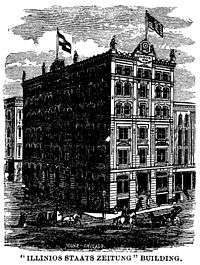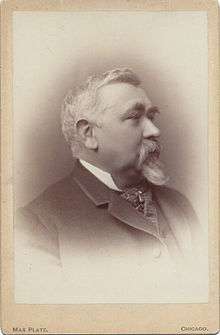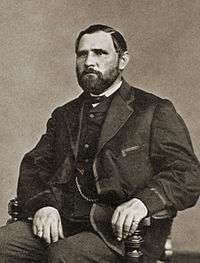Illinois Staats-Zeitung

Illinois Staats-Zeitung (Illinois State Newspaper) was one of the most well known German-language newspapers of the United States published in Chicago, Illinois from 1848 until 1922. Along with the Westliche Post and Anzeiger des Westens, both of St. Louis, it was one of the three most successful German-language newspapers in the United States Midwest.[1]
Publication history
Establishment

The Illinois Staats-Zeitung was founded in April 1848[1] as a weekly, and became a daily in 1851.[2]
Politically, the newspaper was Republican.[3] Hermann Kriege was an early editor.[1] In the 1850s, the paper was taken over by Forty-Eighters and became a major daily newspaper of the Chicago German-born community.[4] In 1851, Georg Schneider joined the staff of the paper and became editor. Among his associates were George Hillgärtner and Daniel Hertel.[1] Schneider played a major role in building the Republican Party in Illinois, a work in which the Illinois Staats-Zeitung played an important function.[5]
The Illinois Staats-Zeitung opposed slavery, and Schneider successfully used the newspaper as a platform to campaign against the Kansas-Nebraska Act.[6] On February 22, 1856 Schneider attended, on behalf of the Illinois Staats-Zeitung, a meeting in Decatur of anti-Nebraska newspapers in Illinois. In total 26 newspapers were represented at the meeting, assembled by the Morgan Journal editor Paul Selby.[7]
Civil War period

During the Civil War years, Lorenz Brentano was proprietor and editor-in-chief,[8] succeeding Schneider.[1] In these years, the paper fully dominated German-language press in the city, as Democratic German-language newspapers were short-lived at the time.[9] At this point, Illinois Staats-Zeitung was the second-largest daily newspaper in the Chicago.[10]
During the war, Wilhelm Rapp was on the staff. He came from the Baltimore Wecker after a riot destroyed its office. After the war, he returned to the Wecker.
In the years after the war, the Staats-Zeitung was published by Prussian immigrant Anton C. Hesing, a former Sheriff of Cook County who moved from partial ownership to complete ownership in 1867.[11] A public figure and political boss of sorts, Hesing would use the pages of his paper for maximum political impact, helping to launch the pro-alcohol People's Party in 1873 and orchestrating the election of Harvey Doolittle Colvin as the 27th Mayor of Chicago. Hesing's independent political venture would fall into disrepute within a few years and the Staats-Zeitung returned to the Republican ranks.
Concurrent with Hesing's assumption of the paper's ownership in 1867, Hermann Raster accepted the position of editor — a position which he would retain until his death in 1891. Raster was the longest holder of this position.[12] Wilhelm Rapp returned to the Staats-Zeitung in 1872, and became editor when Raster died.[13]
Great Chicago Fire


The Staats-Zeitung was particularly hard hit during the October 1871 Great Chicago Fire. Not only was the building housing the publication, including its machinery and type, lost to the flames, but so too were back files of the paper and the publication's records of accounts.[14] Moreover, virtually the entire staff of the paper from editors to press operators found themselves burned out of their homes.[14]
Necessary lead type for producing a German-language paper proved impossible to obtain on short notice and as a temporary measure production was moved briefly to the German enclave of Milwaukee, Wisconsin.[14] After a mere 20 days production returned to a new press in a new facility in Chicago, the city in which the paper would remain for the rest of its existence, with an expansion of physical size following one month later.[14]
A new permanent home for the paper was finally located about one mile away from the Chicago city center, in a new multi-story structure built at the corner of Washington Street and Fifth Avenue.[14] The building measured 100 feet from the basement floor to the peak of the roof, making it one of the largest buildings in its area of town, and was designed with the monumental sensibilities of old Europe.[14]
Staff
In November 1871 publisher Anton Hesing's son, Washington Hesing (1849-1897), an 1870 graduate of Yale College, finished a stint as a political appointee on the Chicago Board of Education and became actively connected with the Staats-Zeitung.[15] The younger Hesing became Managing Editor of the Staats-Zeitung in April 1880, by which time he was a part owner of the publication.[15]
Other notable members of the staff of the Staats-Zeitung were Adolph Wiesner and Caspar Butz.[16] Between 1891 and 1899, the paper had a separate evening edition, Abendblatt (Evening Paper).[17]
Termination
In 1921, the paper was sold for 25,000 dollars.[18] The paper was resurrected as Deutsch-Amerikanische Bürger-Zeitung. A short time before, the Chicagoer Freie Presse had merged with the paper.[17]
See also
Footnotes
- 1 2 3 4 5 Carl Wittke, Refugees of Revolution: The German Forty-Eighters in America. Philadelphia, PA: University of Pennsylvania Press, 1952; pg. 273.
- ↑ "Tägliche Illinois Staats-Zeitung. (Chicago [Ill.]) 1851-1862," Chronicling America, Library of Congress, www.chroniclingamerica.loc.gov/
- ↑ Elliott Shore, Ken Fones-Wolf, and James Philip Danky, The German-American Radical Press: The Shaping of a Left Political Culture, 1850–1940. Urbana, IL: University of Illinois Press, 1992; pg. 87.
- ↑ Shore, Fones-Wolf, and Danky, The German-American Radical Press, pg. 50.
- ↑ George H. Douglas, The Golden Age of the Newspaper. Westport, CT: Greenwood Press, 1999; pg. 213.
- ↑ The Centennial History of Illinois — Vol. Three — The Era of the Civil War
- ↑ Snay, Mitchell. Abraham Lincoln, Owen Lovejoy, and the Emergence of the Republican Party in Illinois
- ↑
 Wilson, James Grant; Fiske, John, eds. (1900). "Brentano, Lorenzo". Appletons' Cyclopædia of American Biography. New York: D. Appleton.
Wilson, James Grant; Fiske, John, eds. (1900). "Brentano, Lorenzo". Appletons' Cyclopædia of American Biography. New York: D. Appleton. - ↑ Shore, Fones-Wolf, and Danky, The German-American Radical Press, pg. 59.
- ↑ Schied, Fred M.. Education and Working Class Culture: German Workers' Clubs in Nineteenth Century Chicago
- ↑ "His 70th Year: Birthday of Anton C. Hesing Celebrated at his Home," Chicago Daily Tribune, vol. 52, no. 7 (Jan. 7, 1893), pg. 4.
- ↑ Inventory of the Hermann Raster Papers at The Newberry Library
- ↑ Albert B. Faust (1963). "Rapp, Wilhelm". Dictionary of American Biography. VIII, Part 1. New York: Charles Scribner's Sons. pp. 384–385.
- 1 2 3 4 5 6 Fairmont Park, Philadelphia: Centennial Newspaper Exhibition, 1876. New York: George P. Rowell & Co., 1876; pg. 244.
- 1 2 A.T. Andreas, History of Chicago From the Earliest Period to the Present Time: Volume III: From the Fire of 1871 Until 1885. In Three Volumes. Chicago: A.T. Andreas Company, 1886; pg. 704.
- ↑ Carl Wittke (1952). Refugees of Revolution: The German Forty-Eighters in America. Philadelphia: University of Pennsylvania Press. p. 274.
- 1 2 Encyclopedia of Chicago — Selected Chicago Daily Newspapers, Foreign Language
- ↑ "German Paper to Resume; Illinois Staats-Zeitung Sold by Receiver in Chicago". New York Times. October 26, 1921. Retrieved 10 February 2009.
Further reading
- Rudolf Hofmeister, The Germans of Chicago. Champaign, IL: Stipes Publishing, 1976.
- John B. Jentz and Richard Schneirov, Chicago in the Age of Capital: Class, Politics, and Democracy During the Civil War and Reconstruction. Urbana, IL: University of Illinois Press, 2012.
- Richard Junger, Becoming the Second City: Chicago's Mass News Media, 1833-1898. Urbana, IL: University of Illinois Press, 2010.
- Peter H. Olden, "Anton C. Hesing: The Rise of a Chicago Boss," Journal of the Illinois State Historical Society, vol. 35, no. 3 (Sept. 1942), pp. 260–287. In JSTOR
External links
- "Illinois Staats-Zeitung". Chicago Foreign Language Press Survey. Chicago Public Library Omnibus Project of the Works Progress Administration of Illinois. 1942 – via Newberry Library. (English translations of selected articles, 1855-1938).